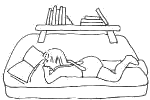by Doris Frese
Yathzee is a dice game played with 5 dice. Players take turns rolling the dice. The winner is the player with the highest score.
Each player has a score card onto which he enters his results. This is too difficult and confusing for kindergarten children. That’s why I developed a score card that the children can use because it contains picture symbols instead of the words.
Yahtzee Score for the Little Ones (for print out)
Gifted five- and six-year-olds, who are particularly interested in numbers and arithmetics, understand the game at first go and also master writing down their scores and adding them up.
Here are the slightly simplified rules for Yahtzee:
In each round the five dice may be rolled up to three times in a turn. To be able to enter points onto the score card, you have to roll certain combinations, for example a triple (three dice with the same number of points). After the first roll, you may put „matching“ dice aside and continue with the remaining dice. For example, if there are two fours on the first roll, I can put them aside and try to get another four with the remaining three dice. If there’s another four, I already have a triple. But I can roll again with the remaining two dice – and maybe I can reach a quadruple or even a quintuple, a „Yahtzee“ [German: „Kniffel“], which yields 50 points, no matter whether with ones, twos,….sixes.
No later than after the third roll you have to decide for a field on the score card. Enter the result here. The triple is represented on the score card by 3 little figures holding hands. For example, if I have rolled three fours, I add up the points and enter the sum (in this case a 12).
You may only enter one result per game in each box.
If my current roll doesn’t correspond to any of the boxes, I have to cross out a field of my choice from the score card.
And this is how the score card works:
In the lower section next to the 1 there is a pair of two figures holding hands, they represent the Double. If after my three rolls I have nothing better than two equal numbers, say two fives, I can enter their sum 10 (2×5) next to the 1 and the two figures.
But if I have four equal numbers, I can enter them next to the 4 and the four figures (with the total score — if the same numbers are threes, the sum to be entered is 12 (4×3) points, if they are sixes, it comes to 24 (4×6) points).
Below this section on the score card we find the „Full House“. This is a combination of Triple and a Double of equal numbers, for example three twos and two sixes. The Full House always scores 25 points, regardless of the particular numbers in the combination.
Next are the Small and the Big Street. For the Small Street I need four consecutive numbers, for example 2-3-4-5; for the big street I need five consecutive numbers, for example 1-2-3-4-5.
For a 50 point score, I need a quintuple, i.e. a „Yahtzee“, of equal numbers.
I can opt for „Chance“ if nothing else fits. It is a good option if the points‘ total is high, as for instance in: 3-4-5-5-6. Then I can enter the sum (in this case 23).
Next to the 2 there is the double Double. I achieve this with two sets of two equal numbers each, as in: (1-) 3-3-4-4.
In the upper part of the score card I can enter results of multiples of equal numbers.
If I have four fours, I can, of course, choose the quadruple, but I can also enter the result (16 in this case) at the top next to the 4. To make it easier for the children to register, the possible sums have already been pre-calculated.
In the upper part it is advisable to enter multiples consisting of bigger numbers, because at the end of the game the subtotal [German: Zwischensumme] will be determined. If it comes to at least 63 points, there is an additional bonus of 35 points.
The game is over when all players have completely filled their score cards. Then the overall total [German: Endsumme] is calculated. To add up the sums I have bought a simple calculator for the children.
Date of publication in German: March 2013
Copyright © Doris Frese, see imprint.
Translation: Arno Zucknick
